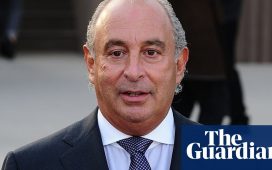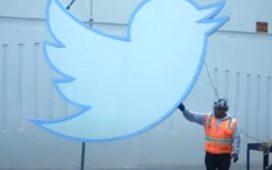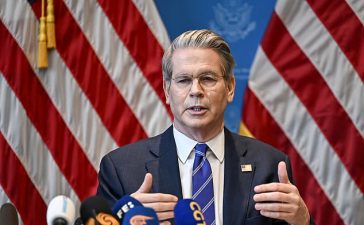
As Gaza City trembled to the sound of bombs, dozens of journalists made their way to a white-walled, two-storey building in the upmarket neighbourhood of Rimal.
It was the morning of 8 October 2023, and the building was the home of Press House, a Palestinian non-profit organisation training and supporting journalists.
Less than 24 hours earlier, Hekmat Yossuf, one of the group’s founders, phoned a colleague. “Get ready, we have to go to the office,” he said.
Within hours they would put the word out to Gaza’s journalists that Press House was opening its supply of flak jackets – light-blue body armour and helmets, emblazoned with “PRESS” and a little cartoon logo of a house with the nib of a pen on its chimney.
Hatem Rawagh, 30, signed the flak jackets out one by one, just over 80 in total, checking the recipients knew how to put them on properly. Yossuf turned the office’s sole meeting room into a space for freelancers to file copy. Dozens of journalists crowded around a snarl of cables and laptops thrown together on the table.
In the centre of the activity was Bilal Jadallah. Tall and thin with a severe expression that masked a dry sense of humour, Press House’s founder had for 10 years nurtured his vision of a politically independent incubator for Palestinian journalism.
It had survived conflict before. In the back garden were 17 olive trees, planted in memory of reporters killed during an escalation in 2014. This time Jadallah felt it would get worse. “We are headed towards war,” he told Rawagh. “A major war.”
Atef Abu Saif, 50, a Palestinian culture minister usually based in the West Bank, had been in Gaza on a short trip. When Hamas launched its assault, he turned up to Press House.
He watched as Gaza’s journalists prepared to cover the war. “The only thing we can agree on is that we have no idea where this is going,” he wrote (Abu Saif declined to be interviewed, but provided journalists with a copy of his diary and permission to quote from it).
Eight months on from the 7 October attack, a reported 37,000 Palestinians have been killed in the Israeli offensive. Foreign media are banned by Israel and Egypt from entering Gaza to cover the war. Palestinian reporters such as those trained by Press House are the only journalists reporting from the ground.
This investigation draws on 15 interviews with current and former Press House board members, staff, financial or diplomatic backers, and widows or other surviving family members. Photo or video evidence of incidents circulating on social media were verified with witnesses. The Guardian worked with Arab Reporters for Investigative Journalists to tell this story, part of a collaboration coordinated by Forbidden Stories, a Paris-based non-profit.
Quick Guide
About this investigation
Show
The Gaza project
The Gaza project is a collaboration of 13 media organisations coordinated by Forbidden Stories, a non-profit continuing the work of journalists under threat.
The Israel-Gaza war has been the deadliest conflict on record for journalists and media workers, according to the Committee to Protect Journalists. As of June 2024, it was investigating 107 deaths, most of them Palestinian journalists. Other organisations estimate higher numbers of casualties.
Foreign media are blocked from entering Gaza to cover the war. This project tells the stories of Palestinian journalists who are either unable to leave or who have chosen to stay, many of whom have been killed.
The Gaza project spoke to dozens of witnesses, and used forensic and open source analysis to understand how and why so many Palestinian journalists have died.
The Committee to Protect Journalists, an American press freedom charity, describes the Israel-Gaza war as the deadliest period for media workers since it began collating its figures three decades ago. As of June it was tracking 108 killings, including two Israelis killed on 7 October.
Many of those who gathered at Press House on 8 October are among that number. Four months after Rawagh handed out the 84 flak jackets, almost a dozen of them had been killed.
Before he founded Press House, Jadallah had been a senior press officer for the Palestinian Authority, the putative government of the Palestinian people set up by peace talks in the 1990s and run by the largely secular Fatah party. In 2007, the Islamist party Hamas seized control of the Gaza Strip. Having lost his job, Jadallah followed his three brothers, each of whom worked for Reuters, into journalism.
But he was frustrated by Gaza’s fractious politics. Like many Palestinians in Gaza, reporters had begun clubbing together into separate politically aligned camps. Supporters of Fatah or Hamas even joined different unions.
He grumbled his frustrations to his friend Ibrahim Barzak, an Associated Press reporter: “No one was taking care of young media practitioners, no one was taking care about what the future of journalism was going to be in Gaza.”
Barzak did not disagree, but when Jadallah suggested they set up a journalists’ club, expressly without connection to any political faction, his first reaction was that the idea was hopeless. “I said to him, ‘It’s a long shot, Bilal.’ This kind of idea is like walking in a minefield,” Barzak recalls.
Nonetheless, together with Yossuf and three other founders, they scraped together a few thousand dollars of their own savings as startup capital, and began the delicate task of persuading Gaza’s political factions to back the idea of a non-partisan journalists’ group.
They held meetings with journalists, human rights activists, businessmen and diplomats. They requested their advice, tested their reactions, slowly brought them on side. Jadallah had always been a “very social person”, Barzak said. But during this period he seemed to possess an almost chameleonic ability to adapt himself to whoever he was talking to.
By the time of Press House’s opening ceremony in 2013, Jadallah had so adeptly navigated the political landscape that both Fatah and Hamas sent congratulatory messages.
Press House became a hive of activity. It ran training programmes to give young reporters a taste of political interviewing. Nabil Shaath, Palestine’s former top international negotiator, was their first interviewee.
The olive trees were planted in the back garden to commemorate fallen journalists. A celebrated Palestinian author, Tawfiq Abu Shomar, donated a collection of antique radios, which Jadallah arranged into a small exhibition.
“Press House is like a fixture on the itinerary for diplomats visiting from Ramallah or Jerusalem,” said Ruben Johansen, a first political secretary at the Norwegian government office in the West Bank, one of Press House’s main financial sponsors. Photos on the group’s Facebook page show diplomats from Britain, Germany, Denmark and elsewhere, all smiling for a photograph with Jadallah in his office.
Yossuf was appointed editor of an in-house press agency, Sawa. He would dart into Jadallah’s office for advice – “updates, ideas, planning, how we should work, what we should accomplish, how we should cover something, even what should be the headline”, said Yossuf.
Jadallah also encouraged new ideas. One day, Plestia Alaqad, a 21-year-old trainee bored out of her mind on an editing course, marched into his office. She reeled off her suggestion for a Press House social media manager – a position that had not previously existed, let alone been assigned to a trainee. Jadallah listened then said yes. “That’s something I love about Bilal,” she said. “He gives people chances to grow.”
Hamas slaughtered 1,139 people on 7 October, most of them Israelis. More than 200 were taken hostage. A shocked and traumatised Israel, reeling from the biggest national security lapse in its history, declared a state of war.
Hundreds of thousands of reservists were called up to the Israel Defense Forces (IDF). Warplanes began bombing Gaza City in an effort to eradicate Hamas. Three Palestinian journalists were killed in gunfire near border crossings. Another died, reportedly alongside nine of his family members, when a bomb struck his home.
Two young photographers, Mohammed Sobh and Hisham Nawajha, were among those who came to collect their light-blue flak jackets. Saeed Taweel had a friend pick one up for him. Later that day all three went to the Ghifari building, Gaza City’s tallest tower and a decent vantage point for night-time filming (their movements were pieced together through conversations with 11 sources, including others camped at the tower).
Shortly after midnight, word spread that the Israelis had phoned in an order to evacuate Hajji tower, an 11-storey building a few blocks away. Several media offices were housed there; journalists with the Agence France-Presse news agency were already rushing out of the building.
Another journalist in the Ghifari building woke to discover that Taweel had gone; he, Sobh and Nawajha had left to cover the strike closer to Hajji. Taweel posted a video about the impending Israeli strike on his Facebook page. Nawajha sent a selfie in his flak jacket and helmet to his wife.
At about 2.25am, as they stood waiting for the strike on Hajji tower, a missile landed almost directly on top of them. Taweel is believed to have been killed instantly. Sobh’s widow said she was told that when rescuers found him, his finger was raised in a gesture of Islamic prayer.
Nawajha’s widow at first read on Facebook that he had died, only to later discover that he was initially unconscious but still alive. Rescuers dragged him from the rubble and rushed him to nearby al-Shifa hospital, where he died.
Later that same day the light-blue flak jackets, stained with dry blood, were returned to Press House. Alaqad posted a video of them on Instagram: “No matter if you’re wearing them or not, you get killed,” she said.
Rawagh took one and laid it over the reception desk in full view of the journalists still there. “They are coming in to see that their friend was killed,” he said. “They have to be very careful because it could be them next.”
Press House quickly fell empty. Most journalists vanished a few days in, after an Israeli airstrike took out the internet.
Those who remained were Jadallah, Rawagh, Abu Saif, Yossuf’s colleague Ahmad Fatima, a photographer so devoted to Press House that he had effectively become Jadallah’s full-time assistant, and a recent recruit, Mohammed al-Jaja, a young English-speaking fundraiser.
Abu Saif’s diary describes how they came and went, leaving to check on worried family members, returning for a shift keeping up Sawa’s coverage of the war. Occasionally they slept on mattresses laid between desks, surrounded by walls of computer cables.
More and more journalists were killed, bombed in their homes or in the field. The IDF began issuing blanket orders to civilians: move south, or risk being considered a terrorist. A stream of refugees headed south, away from northern Gaza.
Rawagh went with them, as did Yossuf, Sawa’s editor, who dreaded the thought of being injured and taken to one of Gaza’s hospitals. But Jadallah chose to stay put. “Press House remains open for any journalist in need,” he told Rawagh.
Almost one month after the beginning of the war, the home of Jaja, the fundraising manager, was destroyed. He, his wife and his two daughters were killed. A video on Facebook shows the obliterated apartment, the stairs in the hallway transformed into a slope of crumbled concrete. (The incident was widely reported as an Israeli attack. The IDF said it was not aware of a strike at the location.)
After he was pulled from the rubble, rescuers placed Jaja’s shrouded body on the ground. A video on social media shows him lying next to the corpses of his little girls, his Press House flak jacket and press card resting on top of his body.
Before the war broke out, he had been scheduled to give a talk at the Council of Europe’s headquarters in Strasbourg that day, on the importance of an independent press. Instead a shocked organiser announced Jaja’s killing to the delegates, his voice audibly cracking.
Jadallah was distraught, but stoical. “I am just going to continue doing our noble work, as I used to do,” he told Barzak. On Facebook, Fatima posted a picture of the last WhatsApp message Jaja had sent him, asking him to find out if anyone nearby was selling bread.
One week later, Fatima was dead too. His wife told journalists that as they lay in bed, an explosion hit the roof of their building. A blade of shrapnel, probably from one of the solar panels on the roof, struck their six-year-old son in the face. Fatima carried him outside to get him to a clinic.
She later discovered he had made it about halfway down the street before another strike hit him. Incredibly, his son survived, his leg riven with shrapnel.
Rawagh became a broken record: “Mr Bilal, you have to go to the south. You have to come here. Everyone needs you. You have to be here with us,” he would say. Those who spoke to Jadallah around this time say he was still opposed to evacuating; that abandoning the house would have felt like leaving Palestine’s journalists behind.
But three people described conversations with him that suggested he had begun to ruminate on his own mortality. “I don’t really see myself making it out of this one,” he confided to Abu Saif one day. He sat down with Mohammed Salem, a former finance manager at Press House, handed him a set of keys and asked him to promise that if he was killed, Salem would do two things: bury his body and take care of Press House.
In mid-November the IDF ordered civilians to leave Gaza City through a designated safe route; a map posted on Facebook with a major highway highlighted in yellow announced a “temporary tactical suspension of military activities” for six hours in the middle of that day.
Two days later Jadallah rang his sister and told her he had decided to leave with his brother-in-law Abdulkarim.
First, they would head east until they reached Salah al-Din street, the main road south out of the city and the IDF’s designated safe route. Then they would drive for about 3 miles (5km) until they reached the Kuwait roundabout. Cars were not permitted to go any further, so Jadallah would walk south for another 3 miles. That would take him to the Wadi checkpoint, the final stop on the way to the refugee camps, where his family was waiting for him.
They made it as far as Salah al-Din street.










